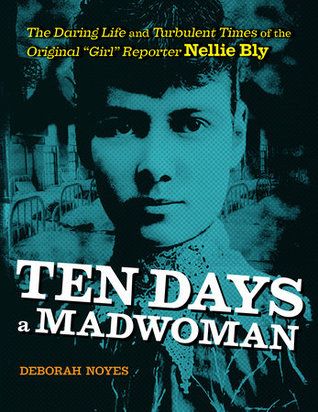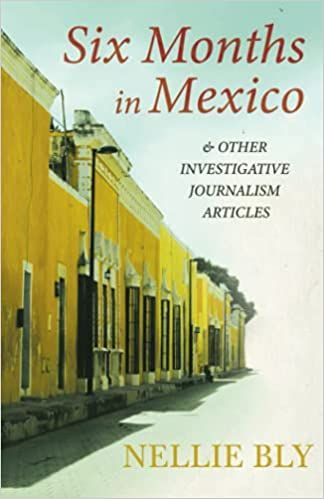January 27, 2022, marks the 100th anniversary of Nellie Bly’s death. Bly, one of the first “girl stunt reporters” made an indelible impact on American journalism, despite being initially seen as clever marketing tool by the news industry.
Born Elizabeth Jane Cochran in 1864, she was one of five children between father Michael Cochran and mother Elizabeth Cochran. Her father died when she was six, and money remained a challenge for the family thereafter.
It was an article in the local Pittsburgh Dispatch where Bly got her start in writing. The piece, which suggested women were good for housekeeping and child birthing, led Bly to writing a response, and the paper’s editor, impressed with her writing, offered her an opportunity to write some more. Again impressed, the editor offered her a full-time position when he recognized that Bly’s arguments — which focused on labor reform and gender reform, among other progressive issues — and because it was customary for women to take on a pen name when publishing in a newspaper, she was given the name Nelly Bly (misprinted as Nellie, but kept as such thereafter).
Bly’s work was investigative and groundbreaking, and the response that the paper received from her columns led to her career taking off. She served as a foreign correspondent at the age of 21, covering Mexican politics and culture, and her work, which was published later in a book, upset many government officials in Mexico because she sympathized with those whose voices were being suppressed by the country’s dictator.
Though response to her work was tremendous, because she riled up factory owners and others with authority for her unflinching reports on working conditions, she found herself periodically reassigned to more “appropriate” topics, including fashion, arts, and theater. Bly’s passion for exposing truths couldn’t be suppressed though, and she left her role at the Dispatch. She welcomed herself into the office of John Pulitzer, owner of the New York World, hoping for a job. She got it, and that work would turn into her explosive look at the conditions in New York City’s Mental Health Hospital on Blackwell Island. She went undercover, pretending to be a mentally ill woman, so she could interact first hand with the workers, owners, and residents of the facility.
It was but one of the major stories of Bly’s career, which spanned decades and helped spawn an entire industry of girl reporters (“stunt reporters”). In the below-noted Sensational, it’s made clear that even as the opportunity for women to break into hard news occurred in this period of American journalism, they were still belittled, still seen as lesser, by the simplicity of what their job titles were — stunts. These reporters made their papers big bucks, encouraging wilder and wilder reports and experiments (see Bly’s competition with Elizabeth Bisland on who could travel the entire world by boat first and fastest).
This is but the tip of Bly’s story. In honor of the anniversary of her death 100 years ago and the legacy she created, here are some outstanding books about Nellie Bly to dig into. These books are going to be very white on account of Bly being white, but I want to highlight Sensational here again: this text does a stellar job of noting that white women were not the only “stunt” reporters, but they were the most “accepted,” and often, because of the use of pen names, women of color doing this reporting were either unknown or have yet to be given full-fledged articles and books of their own. This particular book certainly showcases Bly, but it’s essential reading for understanding the particular U.S. historical moment culturally and for women, laborers, and the journalism machine more broadly.
Books included span age categories, from picture books to adult nonfiction, as well as format, from traditional prose to comics. There are novels in here as well, wherein Nellie plays a lead character. Because she died before public domain laws went into effect, her likeness and works were unable to be protected, which presents both a host of opportunities for creativity, as well as some challenges (see: this bizarre cover for Bly’s seminal work).
Book About Nellie Bly
Eighty Days: Nellie Bly and Elizabeth Bisland’s History-Making Race Around the World by Matthew Goodman
Nellie Bly boarded a steamship with very little on November 14, 1889. Her assignment was to see if she could travel the world faster than Phileas Fogg from Around The World In 80 Days.
The same day, Elizabeth Bisland left on assignment from a rival paper, hoping to do the same in her trip around the world.
They went opposite ways, and the two journalists were a study in contrasts. Goodman shares the highs and lows of the expedition for each reporter.

The Girl Puzzle by Kate Braithwaite
A fictional take on Nellie Bly’s story, and specifically her ten days on Blackwell Island. After earning a reputation for her groundbreaking journalism, Bly’s story years on takes her on a journey of operating an adoption agency in New York City. She’s wealthy now, and she asks her assistant to type up a manuscript about her time on Blackwell…and that assistant unravels all that was true and what was not true about her employer’s affairs while under cover.
Again, reiterating: this is fiction. But it’s a fun and interesting “what if?”

The Incredible Nellie Bly: Journalist, Investigator, Feminist, and Philanthropist by Luciana Cimino and Sergio Algozzino
This comic in translation doesn’t immediately dive into Bly’s story but instead begins with a young female journalism student named Miriam looking to learn from heroines of the field from the past. She “meets” Bly and begins to learn the ups and downs of Bly’s career and how Bly can serve as both a mentor and a visionary for young female reporters even after her death.

The Mad Girls of New York: A Nellie Bly Novel by Maya Rodale (April 26)
Imagine Nellie Bly’s story of feigning mental illness to be admitted into Blackwell Island’s institution, but instead of it being nonfiction, it were fictionalized to add even more details to the conditions she discovered as an undercover reporter. Welcome to this brand new novel, which is part of a forthcoming series following Nellie as she uncovers the seediest parts of New York City during the Gilded Age.

Mad Woman: Nellie Bly by Louisa Treger (August 22)
Trager’s historical fiction takes the story of Bly’s ten days on Blackwell Island and turns it into a propulsive, compelling novel of the lengths one woman will go to expose the truth about how those most in need of help are kept in danger.

A Race Around the World: The True Story of Nellie Bly and Elizabeth Bisland by Caroline Starr Rose and Alexandra Bye
The round-the-world race is one of the most incredible stories of Bly’s life, so it’s not a surprise to see that as the basis of more than one book. This time, though, the story is for young readers who love a good adventurous nonfiction picture book.

Sensational: The Hidden History of America’s “Girl Stunt Reporters” by Kim Todd
An absorbing history of the “girl stunt reporters” — AKA investigative reporters — of the late 19th century. What begins with Nellie Bly opens up a whole history of other (white) women who were hired to do investigative reporting but who were never seen as hard-hitting journalists. Todd offers such fascinating insight and critique of how these women were doing incredible journalism and being seen not as doing real, impactful work, but were used to bolster a newspaper’s sales for what would be done next (not what the reporting revealed). The bulk of these reporters were white women, but Todd talks about how women of color were doing good work but it wasn’t seen in the same “stunt reporter” manner.

Ten Days a Madwoman: The Daring Life and Turbulent Times of the Original “Girl” Reporter, Nellie Bly by Deborah Noyes
This entire book is a fascinating, well-written, engaging account of Bly’s career, from her beginnings through to the end. It follows many pieces of history that are familiar and offers insights and interesting aspects we may not otherwise know about Bly nor the time period. There’s an anecdote in Noyes’s middle grade/YA nonfiction entry about how Willa Cather wrote a scathing letter against Bly’s journalism that echoes today’s social action and movement and criticism. If anything, this time period surprisingly mirrors ours, but without the high tech aspects.
Also, this is the book where I first learned (and fell in love with the fact) Nellie had a pet monkey named McGinty, picked up on her round-the-world trip, and he broke all of her dishes after their voyage around the globe.

What Girls Are Good For: A Novel of Nellie Bly by David Blixt
Blitx writes all of the facts of Bly’s life but does so as a novel, engaging readers of young adult fiction into the world of the young woman who began her career with a letter and continued it the world over.
Books by Nellie Bly

Around the World in Seventy-Two Days and Other Writings by Nellie Bly
Travel with Nellie across the world on her infamous journey. This is adventure journalism and a travelogue all in one, and it’s wrapped up with even more of Bly’s writing in a convenient (and classic) package.

The Mystery of Central Park by Nellie Bly
Originally serialized in the New York Evening World in July 1889, this is Bly’s only known work of fiction. It’s a story of a man named Richard who, despite being wealthy and well-off, cannot get the love of his life Penelope to agree to marriage. But when a dead body shows up in Central Park, Penelope offers him a proposal he can’t refuse: solve the mystery and she’ll agree to marriage.

Six Months in Mexico & Other Investigative Journalism Articles by Nellie Bly
Fewer titles about Bly cover her six months of travel and writing in Mexico, but it was groundbreaking work for a woman of her time and led to a number of doors both opening and slamming shut in her face. Dig into those works with this collected travel and reporting.

Ten Days in the Madhouse by Nellie Bly
Finally, pick up the book based on the work that catapulted Bly into the public eye and earned her a reputation as a ruthless reporter willing to go and do things that others had never done before.
Note that the writing here talks in depth about the terrible mistreatment of people with mental illness and doesn’t shy away from highlighting that abuse.
Bly’s most well-known writing explored the conditions of Blackwell Island, and if that’s a topic that fascinates you, check out Damnation Island: Poor, Sick, Mad, and Criminal by Stacy Horn that offers insight into Bly’s work and the grander picture of mental health, institutionalization, and abuse during the late 19th century in New York City.
For more great reads on women in history, dive into these queer women’s history reads, these women’s history reads, and this feminist library history.
Deep dives into a single woman’s life your jam? You’ll want to read about situating white women’s history in context (especially how it relates to Laura Ingalls Wilder) and a look at what it means to “uncover” the “truth” behind an artist like photographer Vivian Maier.














